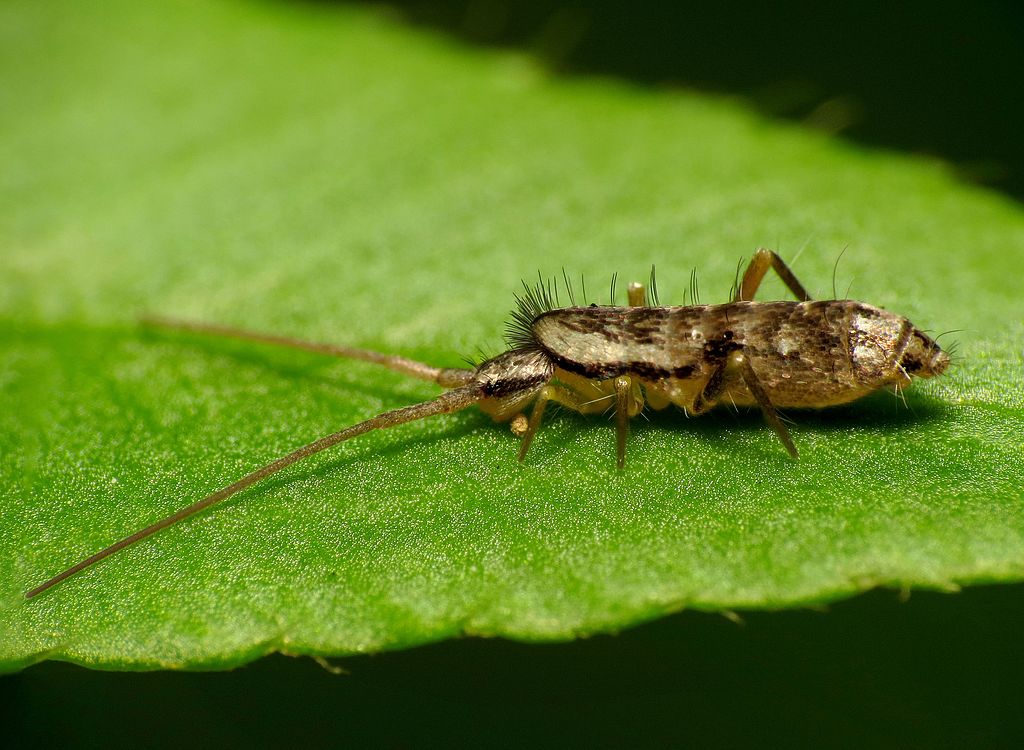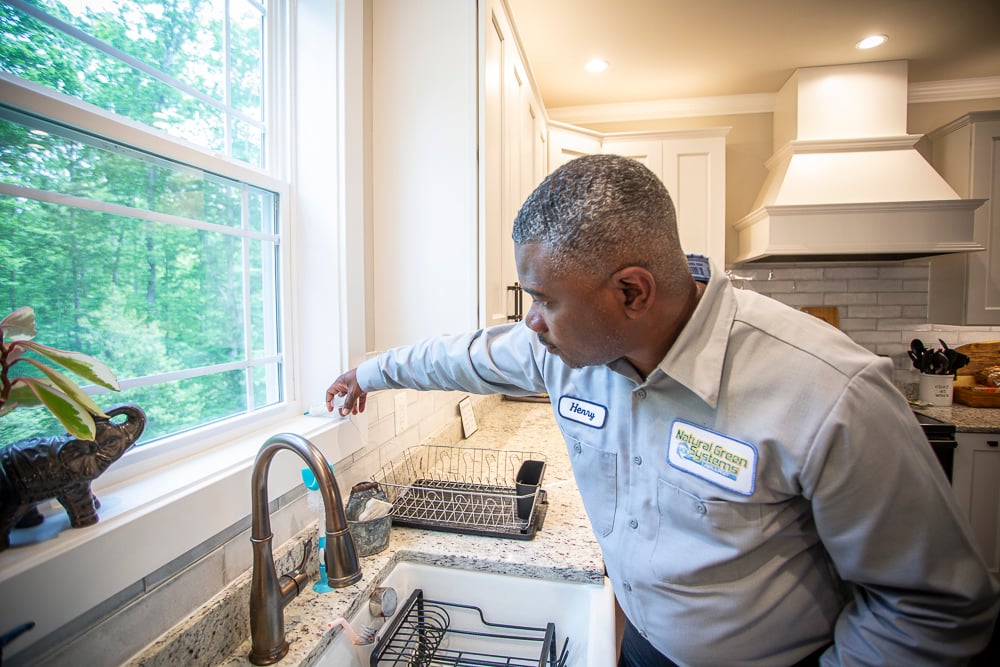How to Identify and Get Rid of Springtails in Your Maryland Home
Sometimes it’s not the biting or stinging bugs that are the worst.
Don’t misunderstand us: They are bad, too. But often the worst bugs are the nuisance pests, the ones that get in your way as you're conducting your normal day or that you have to constantly pick up after once you find them in your home.
One of these in Central and Southern Maryland is the springtail. These tiny pests may not cause much damage, but they still aren’t welcome in your home.
Use This Pest Guide to Identify & Eliminate 28 Different Pests!
Let’s review what these bugs look like and how you can prevent springtails.
Springtails in Maryland
Finding out if you have springtails starts with proper identification.
Springtails are extremely tiny insects, ranging from 1 to 2 millimeters long. That’s less than ⅛ of an inch, so they are pretty hard to spot.
 Gray in color, they have small bodies and a forked appendage in the back that gives them the ability to jump and move away quickly if they sense your approach. Just what you want: a small jumping pest invading your home.
Gray in color, they have small bodies and a forked appendage in the back that gives them the ability to jump and move away quickly if they sense your approach. Just what you want: a small jumping pest invading your home.
You might be wondering, “Where do springtails come from?” Springtails are drawn to moisture, feeding on algae, fungi, pollen, and decaying organic matter. Springtails may be an important part of soil ecosystems, but they are a nuisance in kitchens, bathrooms, and basements in Central and Southern Maryland homes. While they root through soil and leaves to find food, they may also be drawn to mold or fungi in your walls or windows.
 In fact, consistent dampness, leaks, or mold can cause large infestations of springtails in Maryland homes.
In fact, consistent dampness, leaks, or mold can cause large infestations of springtails in Maryland homes.
How to Get Rid of Springtails in Your Home
When you identify springtails in your home, don’t panic. They won’t hurt or bite your home’s residents, and they won’t damage your clothes or building materials the way termites or other pests might.
But they sure can be annoying when you find them under carpets or near basement drains inside your house.
Here are some of the best ways to keep them outside where they belong.
1. Control Moisture to Prevent Springtails
Springtails come into your home for only two reasons: moisture and food.
Outside they eat decaying vegetation, algae, and bacteria, fertilizing the soil. Inside, they are attracted to bits of mold in your walls. So if you find springtails indoors, it’s a good sign you have another problem to deal with in your home, particularly related to moisture.
 If signs of moisture and humidity are high in your home, springtails will continue to be drawn in. And this can happen no matter if your home is old or new. Even newly built homes can have small mold issues if they were exposed to humidity or rain during construction.
If signs of moisture and humidity are high in your home, springtails will continue to be drawn in. And this can happen no matter if your home is old or new. Even newly built homes can have small mold issues if they were exposed to humidity or rain during construction.
To prevent springtails, manage dampness, mold, and humidity in your Central or Southern Maryland home by fixing water leaks and drying out moist areas with dehumidifiers.
2. Maintain Your Irrigation System
Since springtails are drawn to moisture, you don’t want things you’re doing outside to draw moisture closer to your home, along with pests that like those conditions like springtails.
 One thing that can create that excess moisture is your irrigation system. If there are leaks, this can elevate moisture levels near your home. Once springtails are around your foundation or basement windows, the next step inside is easier.
One thing that can create that excess moisture is your irrigation system. If there are leaks, this can elevate moisture levels near your home. Once springtails are around your foundation or basement windows, the next step inside is easier.
Keep your irrigation system and faucets leak-free to prevent springtails.
3. Manage Your Home Ventilation
Humidity hangs in the air when there’s no circulation.
If springtails are drawn to humidity and moisture, it’s natural to assume how to get rid of springtails involves managing this humidity.
To do that, boost the air circulation in your home to eliminate dampness.
4. Embrace Pest Control Basics
To prevent springtails and a variety of bugs, you can also follow some simple pest control basics.
Start by keeping branches pruned around your home, and store any firewood you have a minimum of 20 feet away from your home.
 Storing food in airtight containers and getting rid of garbage regularly, as well as cleaning up after spills, are also always good ideas.
Storing food in airtight containers and getting rid of garbage regularly, as well as cleaning up after spills, are also always good ideas.
And then to make it harder for springtails to enter your home, make sure to seal cracks and crevices around windows or your foundation with silicone or caulk.
5. Bring In a Pest Control Professional
You might suspect springtails, but you might not have the time to search for such small pests, let alone have the knowledge to know where to look.
If you suspect springtails, hiring a pest control professional can certainly help.
 A pest control technician will conduct a general insect inspection, looking for common entry points, sealing anything that is ½ inch in size or less. They can even tell you where you have gaps larger than ½ inch that might need additional repair work. This will help you with your prevention strategies above. They can also tell you some things they see that might attract pests and provide you with some tips to follow to keep them away.
A pest control technician will conduct a general insect inspection, looking for common entry points, sealing anything that is ½ inch in size or less. They can even tell you where you have gaps larger than ½ inch that might need additional repair work. This will help you with your prevention strategies above. They can also tell you some things they see that might attract pests and provide you with some tips to follow to keep them away.
Signing up for general pest control treatments that include inspections can make preventing springtails easier. You don't have to worry about finding bugs because you have professional eyes on your property, and the perimeter treatments they provide can further even keep pests from coming in.
Suspect Springtails? Let Natural Green Help
Springtails may not be the worst pests you can find in your Central and Southern Maryland home. Think cockroaches, mice, and termites. Ew!
But when springtails invade your space, they can be pesky. No one likes to feel as if their home is becoming a nest for pests.
We understand. If you’re concerned about springtails in your home, we’d like to help. Hiring a reputable pest control company with experienced technicians can give you peace of mind, while eliminating these bugs for good.
We want you to be able to enjoy your home -- insect-free. Give us a call and we’ll bring our proven pest control experience and create a custom plan for your Central and Southern Maryland residence. Get started today with a free quote.
Sometimes it’s not the biting or stinging bugs that are the worst.
Don’t misunderstand us: They are bad, too. But often the worst bugs are the nuisance pests, the ones that get in your way as you're conducting your normal day or that you have to constantly pick up after once you find them in your home.
One of these in Central and Southern Maryland is the springtail. These tiny pests may not cause much damage, but they still aren’t welcome in your home.
Use This Pest Guide to Identify & Eliminate 28 Different Pests!
Let’s review what these bugs look like and how you can prevent springtails.
Springtails in Maryland
Finding out if you have springtails starts with proper identification.
Springtails are extremely tiny insects, ranging from 1 to 2 millimeters long. That’s less than ⅛ of an inch, so they are pretty hard to spot.
 Gray in color, they have small bodies and a forked appendage in the back that gives them the ability to jump and move away quickly if they sense your approach. Just what you want: a small jumping pest invading your home.
Gray in color, they have small bodies and a forked appendage in the back that gives them the ability to jump and move away quickly if they sense your approach. Just what you want: a small jumping pest invading your home.
You might be wondering, “Where do springtails come from?” Springtails are drawn to moisture, feeding on algae, fungi, pollen, and decaying organic matter. Springtails may be an important part of soil ecosystems, but they are a nuisance in kitchens, bathrooms, and basements in Central and Southern Maryland homes. While they root through soil and leaves to find food, they may also be drawn to mold or fungi in your walls or windows.
 In fact, consistent dampness, leaks, or mold can cause large infestations of springtails in Maryland homes.
In fact, consistent dampness, leaks, or mold can cause large infestations of springtails in Maryland homes.
How to Get Rid of Springtails in Your Home
When you identify springtails in your home, don’t panic. They won’t hurt or bite your home’s residents, and they won’t damage your clothes or building materials the way termites or other pests might.
But they sure can be annoying when you find them under carpets or near basement drains inside your house.
Here are some of the best ways to keep them outside where they belong.
1. Control Moisture to Prevent Springtails
Springtails come into your home for only two reasons: moisture and food.
Outside they eat decaying vegetation, algae, and bacteria, fertilizing the soil. Inside, they are attracted to bits of mold in your walls. So if you find springtails indoors, it’s a good sign you have another problem to deal with in your home, particularly related to moisture.
 If signs of moisture and humidity are high in your home, springtails will continue to be drawn in. And this can happen no matter if your home is old or new. Even newly built homes can have small mold issues if they were exposed to humidity or rain during construction.
If signs of moisture and humidity are high in your home, springtails will continue to be drawn in. And this can happen no matter if your home is old or new. Even newly built homes can have small mold issues if they were exposed to humidity or rain during construction.
To prevent springtails, manage dampness, mold, and humidity in your Central or Southern Maryland home by fixing water leaks and drying out moist areas with dehumidifiers.
2. Maintain Your Irrigation System
Since springtails are drawn to moisture, you don’t want things you’re doing outside to draw moisture closer to your home, along with pests that like those conditions like springtails.
 One thing that can create that excess moisture is your irrigation system. If there are leaks, this can elevate moisture levels near your home. Once springtails are around your foundation or basement windows, the next step inside is easier.
One thing that can create that excess moisture is your irrigation system. If there are leaks, this can elevate moisture levels near your home. Once springtails are around your foundation or basement windows, the next step inside is easier.
Keep your irrigation system and faucets leak-free to prevent springtails.
3. Manage Your Home Ventilation
Humidity hangs in the air when there’s no circulation.
If springtails are drawn to humidity and moisture, it’s natural to assume how to get rid of springtails involves managing this humidity.
To do that, boost the air circulation in your home to eliminate dampness.
4. Embrace Pest Control Basics
To prevent springtails and a variety of bugs, you can also follow some simple pest control basics.
Start by keeping branches pruned around your home, and store any firewood you have a minimum of 20 feet away from your home.
 Storing food in airtight containers and getting rid of garbage regularly, as well as cleaning up after spills, are also always good ideas.
Storing food in airtight containers and getting rid of garbage regularly, as well as cleaning up after spills, are also always good ideas.
And then to make it harder for springtails to enter your home, make sure to seal cracks and crevices around windows or your foundation with silicone or caulk.
5. Bring In a Pest Control Professional
You might suspect springtails, but you might not have the time to search for such small pests, let alone have the knowledge to know where to look.
If you suspect springtails, hiring a pest control professional can certainly help.
 A pest control technician will conduct a general insect inspection, looking for common entry points, sealing anything that is ½ inch in size or less. They can even tell you where you have gaps larger than ½ inch that might need additional repair work. This will help you with your prevention strategies above. They can also tell you some things they see that might attract pests and provide you with some tips to follow to keep them away.
A pest control technician will conduct a general insect inspection, looking for common entry points, sealing anything that is ½ inch in size or less. They can even tell you where you have gaps larger than ½ inch that might need additional repair work. This will help you with your prevention strategies above. They can also tell you some things they see that might attract pests and provide you with some tips to follow to keep them away.
Signing up for general pest control treatments that include inspections can make preventing springtails easier. You don't have to worry about finding bugs because you have professional eyes on your property, and the perimeter treatments they provide can further even keep pests from coming in.
Suspect Springtails? Let Natural Green Help
Springtails may not be the worst pests you can find in your Central and Southern Maryland home. Think cockroaches, mice, and termites. Ew!
But when springtails invade your space, they can be pesky. No one likes to feel as if their home is becoming a nest for pests.
We understand. If you’re concerned about springtails in your home, we’d like to help. Hiring a reputable pest control company with experienced technicians can give you peace of mind, while eliminating these bugs for good.
We want you to be able to enjoy your home -- insect-free. Give us a call and we’ll bring our proven pest control experience and create a custom plan for your Central and Southern Maryland residence. Get started today with a free quote.
Image Source: Springtail on leaf, springtail, springtail header, sprinkler system
Share This
Sometimes it’s not the biting or stinging bugs that are the worst.
Don’t misunderstand us: They are bad, too. But often the worst bugs are the nuisance pests, the ones that get in your way as you're conducting your normal day or that you have to constantly pick up after once you find them in your home.
One of these in Central and Southern Maryland is the springtail. These tiny pests may not cause much damage, but they still aren’t welcome in your home.
Use This Pest Guide to Identify & Eliminate 28 Different Pests!
Let’s review what these bugs look like and how you can prevent springtails.
Springtails in Maryland
Finding out if you have springtails starts with proper identification.
Springtails are extremely tiny insects, ranging from 1 to 2 millimeters long. That’s less than ⅛ of an inch, so they are pretty hard to spot.
 Gray in color, they have small bodies and a forked appendage in the back that gives them the ability to jump and move away quickly if they sense your approach. Just what you want: a small jumping pest invading your home.
Gray in color, they have small bodies and a forked appendage in the back that gives them the ability to jump and move away quickly if they sense your approach. Just what you want: a small jumping pest invading your home.
You might be wondering, “Where do springtails come from?” Springtails are drawn to moisture, feeding on algae, fungi, pollen, and decaying organic matter. Springtails may be an important part of soil ecosystems, but they are a nuisance in kitchens, bathrooms, and basements in Central and Southern Maryland homes. While they root through soil and leaves to find food, they may also be drawn to mold or fungi in your walls or windows.
 In fact, consistent dampness, leaks, or mold can cause large infestations of springtails in Maryland homes.
In fact, consistent dampness, leaks, or mold can cause large infestations of springtails in Maryland homes.
How to Get Rid of Springtails in Your Home
When you identify springtails in your home, don’t panic. They won’t hurt or bite your home’s residents, and they won’t damage your clothes or building materials the way termites or other pests might.
But they sure can be annoying when you find them under carpets or near basement drains inside your house.
Here are some of the best ways to keep them outside where they belong.
1. Control Moisture to Prevent Springtails
Springtails come into your home for only two reasons: moisture and food.
Outside they eat decaying vegetation, algae, and bacteria, fertilizing the soil. Inside, they are attracted to bits of mold in your walls. So if you find springtails indoors, it’s a good sign you have another problem to deal with in your home, particularly related to moisture.
 If signs of moisture and humidity are high in your home, springtails will continue to be drawn in. And this can happen no matter if your home is old or new. Even newly built homes can have small mold issues if they were exposed to humidity or rain during construction.
If signs of moisture and humidity are high in your home, springtails will continue to be drawn in. And this can happen no matter if your home is old or new. Even newly built homes can have small mold issues if they were exposed to humidity or rain during construction.
To prevent springtails, manage dampness, mold, and humidity in your Central or Southern Maryland home by fixing water leaks and drying out moist areas with dehumidifiers.
2. Maintain Your Irrigation System
Since springtails are drawn to moisture, you don’t want things you’re doing outside to draw moisture closer to your home, along with pests that like those conditions like springtails.
 One thing that can create that excess moisture is your irrigation system. If there are leaks, this can elevate moisture levels near your home. Once springtails are around your foundation or basement windows, the next step inside is easier.
One thing that can create that excess moisture is your irrigation system. If there are leaks, this can elevate moisture levels near your home. Once springtails are around your foundation or basement windows, the next step inside is easier.
Keep your irrigation system and faucets leak-free to prevent springtails.
3. Manage Your Home Ventilation
Humidity hangs in the air when there’s no circulation.
If springtails are drawn to humidity and moisture, it’s natural to assume how to get rid of springtails involves managing this humidity.
To do that, boost the air circulation in your home to eliminate dampness.
4. Embrace Pest Control Basics
To prevent springtails and a variety of bugs, you can also follow some simple pest control basics.
Start by keeping branches pruned around your home, and store any firewood you have a minimum of 20 feet away from your home.
 Storing food in airtight containers and getting rid of garbage regularly, as well as cleaning up after spills, are also always good ideas.
Storing food in airtight containers and getting rid of garbage regularly, as well as cleaning up after spills, are also always good ideas.
And then to make it harder for springtails to enter your home, make sure to seal cracks and crevices around windows or your foundation with silicone or caulk.
5. Bring In a Pest Control Professional
You might suspect springtails, but you might not have the time to search for such small pests, let alone have the knowledge to know where to look.
If you suspect springtails, hiring a pest control professional can certainly help.
 A pest control technician will conduct a general insect inspection, looking for common entry points, sealing anything that is ½ inch in size or less. They can even tell you where you have gaps larger than ½ inch that might need additional repair work. This will help you with your prevention strategies above. They can also tell you some things they see that might attract pests and provide you with some tips to follow to keep them away.
A pest control technician will conduct a general insect inspection, looking for common entry points, sealing anything that is ½ inch in size or less. They can even tell you where you have gaps larger than ½ inch that might need additional repair work. This will help you with your prevention strategies above. They can also tell you some things they see that might attract pests and provide you with some tips to follow to keep them away.
Signing up for general pest control treatments that include inspections can make preventing springtails easier. You don't have to worry about finding bugs because you have professional eyes on your property, and the perimeter treatments they provide can further even keep pests from coming in.
Suspect Springtails? Let Natural Green Help
Springtails may not be the worst pests you can find in your Central and Southern Maryland home. Think cockroaches, mice, and termites. Ew!
But when springtails invade your space, they can be pesky. No one likes to feel as if their home is becoming a nest for pests.
We understand. If you’re concerned about springtails in your home, we’d like to help. Hiring a reputable pest control company with experienced technicians can give you peace of mind, while eliminating these bugs for good.
We want you to be able to enjoy your home -- insect-free. Give us a call and we’ll bring our proven pest control experience and create a custom plan for your Central and Southern Maryland residence. Get started today with a free quote.
Image Source: Springtail on leaf, springtail, springtail header, sprinkler system
Share This
Topics: Pest Control


